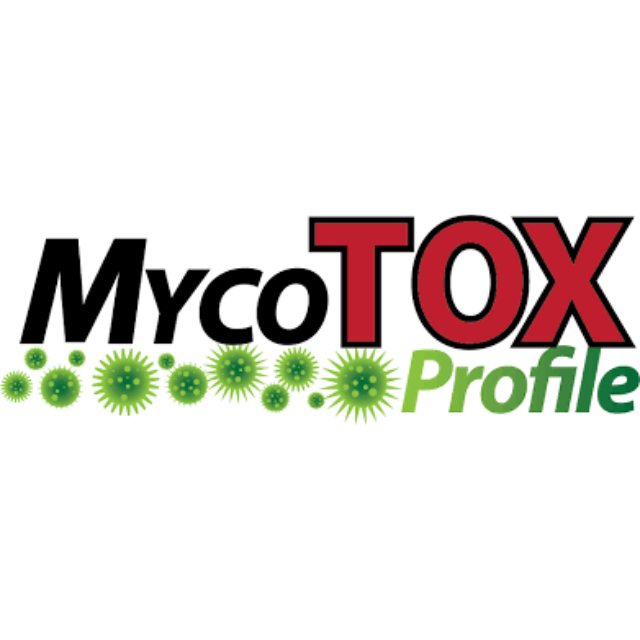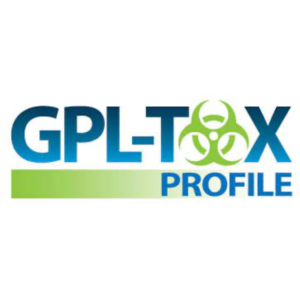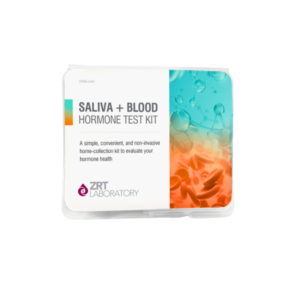MycoTOX Profile
Mycotoxins (toxins from mold) are some of the most prevalent toxins in the environment. Mycotoxins are metabolites produced by fungi like mold, which can infest buildings, vehicles, and foodstuffs. Most mycotoxin exposures in North America, Europe, and Australia are through airborne exposure. Food may be a major source of mycotoxins in third-world nations that lack government inspection of foods, especially the grains such as rice, corn, wheat, rye, and barley. Many grains that are harvested have been found to be contaminated with mycotoxins but little of such harvests are discarded and are frequently sold for animal feeds such as dog food or feed for cows, pigs, chickens, turkeys, and horses.
Fungi can grow on almost any surface, especially if the environment is warm and wet. Inner wall materials of buildings, wallpaper, fiber glass insulation, ceiling tiles, and gypsum support are all good surfaces for fungi to colonize. These fungi then release mycotoxins into the environment causing symptoms of many different chronic diseases. Diseases and symptoms linked to mycotoxin exposure include fever, pneumonia-like symptoms, heart disease, rheumatic disease, asthma, sinusitis, cancer, memory loss, vision loss, chronic fatigue, skin rashes, depression, ADHD, anxiety, and liver damage. With the MycoTOX Profile we can identify mycotoxin exposures and make recommendations for detoxification treatments that have been effective.
GENERA OF MOLD TESTED BY THE MYCOTOX PROFILE
We are currently measuring 11 different mycotoxins in our test from a wide variety of 13 mold types (genera) including Aspergillus, Penicillium, Fusarium, Myrothecium, Stachybotrys, Bipolaris, Gibberella, Chaetomium, Trichoderma, Trichothecium, Cephalosporium, Verticimonosporium, and Monascus. Since each of these genera contain multiple species, the MycoTOX Profile is likely to detect hundreds of mold species. In addition, poisonous mushrooms also produce some of the same mycotoxins as the molds. This makes the MycoTOX Profile the most comprehensive test on the market and it is the most cost-effective.
MARKERS IN THE MYCOTOX PROFILE
The strains of molds we evaluate can produce many different mycotoxins. We have developed a test that provides extensive coverage, allowing us to detect most mold exposures.
AFLATOXIN M1 (AFM1)
Aflatoxin M1 (AFM1) is the main metabolite of aflatoxin B1, which is a mycotoxin produced by different species of the genus Aspergillus. Aflatoxins are some of the most carcinogenic substances in the environment. Aflatoxin susceptibility is dependent on multiple different factors such as age, sex, and diet. Aflatoxin can be found in beans, corn, rice, tree nuts, wheat, milk, eggs, and meat. In cases of lung aspergilloma, aflatoxin has been found in human tissue specimens. Aflatoxin can cause liver damage, cancer, mental impairment, abdominal pain, hemorrhaging, coma, and death. Aflatoxin has been shown to inhibit leucocyte proliferation. Clinical signs of aflatoxicosis are non-pruritic macular rash, headache, gastrointestinal dysfunction (often extreme), lower extremity edema, anemia, and jaundice. The toxicity of aflatoxin is increased in the presence of ochratoxin and zearalenone.
OCHRATOXIN A (OTA)
Ochratoxin A (OTA) is a nephrotoxic, immunotoxic, and carcinogenic mycotoxin. This chemical is produced by molds in the Aspergillus and Penicillium families. Exposure is primarily through contaminated foods such as cereals, grape juices, dairy, spices, wine, dried vine fruit, and coffee. Exposure to OTA can also come from inhalation exposure in water-damaged buildings. OTA can lead to kidney disease and adverse neurological effects. Studies have shown that OTA can cause significant oxidative damage to multiple brain regions and the kidneys. Dopamine levels in the brain of mice have been shown to be decreased after exposure to OTA.
STERIGMATOCYSTIN (STG)
Sterigmatocystin (STG) is a mycotoxin that is closely related to aflatoxin. STG is produced from several types of mold such as Aspergillus, Penicillium, and Bipolaris. It is carcinogenic, particularly in the cells of the GI tract and liver. STG has been found in the dust from damp carpets. It is also a contaminant of many foods including grains, corn, bread, cheese, spices, coffee beans, soybeans, pistachio nuts, and animal feed. In cases of lung aspergilloma, STG has been found in human tissue specimens. The toxicity of STG affects the liver, kidneys, and immune system. Tumors have been found in the lungs of rodents that were exposed to STG. Oxidative stress becomes measurably elevated during STG exposure, which causes a depletion of antioxidants such as glutathione, particularly in the liver.
RORIDIN E
Roridin E is a macrocyclic trichothecene produced by the mold genera Fusarium, Myrothecium, Trichoderma, Trichothecium, Cephalosporium, Verticimonosporium, and Stachybotrys (i.e. black mold). Trichothecenes are frequently found in buildings with water damage but can also be found in contaminated grain. This is a very toxic compound, which inhibits protein biosynthesis by preventing peptidyl transferase activity. Trichothecenes are considered extremely toxic and have been used as biological warfare agents. Even low levels of exposure to macrocyclic trichothecenes can cause severe neurological damage, immunosuppression, endocrine disruption, cardiovascular problems, and gastrointestinal distress.
VERRUCARIN A
Verrucarin A is a macrocyclic trichothecene mycotoxin produced from Stachybotrys, Fusarium, and Myrothecium molds. Trichothecenes are frequently found in buildings with water damage but can also be found in contaminated grain. This is a very toxic compound, which inhibits protein biosynthesis by preventing peptidyl transferase activity. Trichothecenes are considered extremely toxic and have been used as biological warfare agents. Even low levels of exposure to macrocyclic trichothecenes can cause severe neurological damage, immunosuppression, endocrine disruption, cardiovascular problems, and gastrointestinal distress.
ENNIATIN B
Enniatin B1 is a fungal metabolite categorized as a cyclohexa-depsipeptides toxin produced by the molds of the Fusarium species. These species are common cereal contaminants. Grains in many different countries have recently been contaminated with high levels of enniatin. The toxic effects of enniatin are caused by the inhibition of the acyl-CoA cholesterol acyltransferase, depolarization of mitochondria, and inhibition of osteoclastic bone resorption. Enniatin has antibiotic properties and chronic exposure may lead to weight loss, fatigue, and liver disease.
ZEARALENONE (ZEA)
Zearalenone (ZEA) is a mycotoxin that is produced by species of the mold genera Fusarium and Gibberella. It has been shown to be hepatotoxic, hematotoxic, immunotoxic, and genotoxic. ZEA is commonly found in several foods in the US, Europe, Asia, and Africa including wheat, barley, rice, and maize. ZEA has estrogenic activity and exposure to ZEA can lead to reproductive changes. ZEA’s estrogenic activity is higher than that of other non-steroidal isoflavones (compounds that have estrogen-like effects) such as soy and clover. ZEA exposure can result in thymus atrophy and alter spleen lymphocyte production as well as impaired lymphocyte immune response, which leads to patients being susceptible to disease.
GLIOTOXIN*
Gliotoxin (GTX) is produced by the mold genus Aspergillus and perhaps Candida species. Aspergillus spreads in the environment by releasing conidia which are capable of infiltrating the small alveolar airways of individuals. To evade the body’s defenses Aspergillus releases gliotoxin to inhibit the immune system. One of the targets of gliotoxin is PtdIns (3,4,5) P3. This results in the downregulation of phagocytic immune defense, which can lead to the exacerbation of polymicrobial infections. Gliotoxin impairs the activation of T-cells and induces apoptosis in monocytes and in monocyte-derived dendritic cells. These impairments can lead to multiple neurological syndromes.
MYCOPHENOLIC ACID*
Mycophenolic Acid (MPA) is produced by the Penicillium fungus. MPA is an immunosuppressant which inhibits the proliferation of B and T lymphocytes. MPA exposure can increase the risk of opportunistic infections such as Clostridia and Candida. MPA is associated with miscarriage and congenital malformations when the woman is exposed in pregnancy.
DIHYDROCITRINONE*
Dihydrocitrinone is a metabolite of Citrinin (CTN), which is a mycotoxin that is produced by mold species of the genera Aspergillus, Penicillium, and Monascus. CTN exposure can lead to nephropathy, because of its ability to increase permeability of mitochondrial membranes in the kidneys. The three most common exposure routes are through ingestion, inhalation, and skin contact. CTN has been shown to be carcinogenic in rat studies. Multiple studies have linked CTN exposure to a suppression of the immune response.
CHAETOGLOBOSIN A*
Chaetoglobosin A (CHA) is produced by the mold Chaetomium globosum (CG). CG is commonly found in homes that have experienced water damage. Up to 49% of water-damaged buildings have been found to have CG. CHA is highly toxic, even at minimal doses. CHA disrupts cellular division and movement. Most exposure to CG is through the mycotoxins because the spores tend not to aerosolize. Exposure to CHA has been linked to neuronal damage, peritonitis, and cutaneous lesions.
40 SPECIES OF MOLD MEASURED IN THE MYCOTOX PROFILE
-
Acremonium sp.
-
Alternaria
-
A. flavipes
-
Aspergillus flavus
-
A. fumigatus
-
A. niger
-
A. ochraceus
-
A. parasiticus
-
A. sydowii
-
A. versicolor
-
A. viridictum
-
Aureobasidium
-
Chaetomium
-
Cladosporium
-
Cunninghamella
-
Cylindrocarpon
-
Dendrodochium
-
Exophiala
-
Fusarium avenaceum
-
F. cerealis
-
F. clumonrum
-
F. equiseti
-
F. graminearum
-
F. incarnatum
-
F. moniliforme
-
F. solani
-
F. verticillioides
-
Myrothecium roridum
-
M. verrucaria
-
Penicillium carbonarius
-
P. nordicum
-
P. stoloniferum
-
P. verrucosum
-
Phoma sp.
-
Rhodotorula
-
Scopulariopsis
-
Stachybotrys
-
S. chartarum
-
Trichoderma viride
-
Ulocaldium
-
Verticillium
Lab results consultations are not included in the testing fee. If you would like one on one guidance and an individualized assessment of your lab results, book your Lab Results Appointment here.





